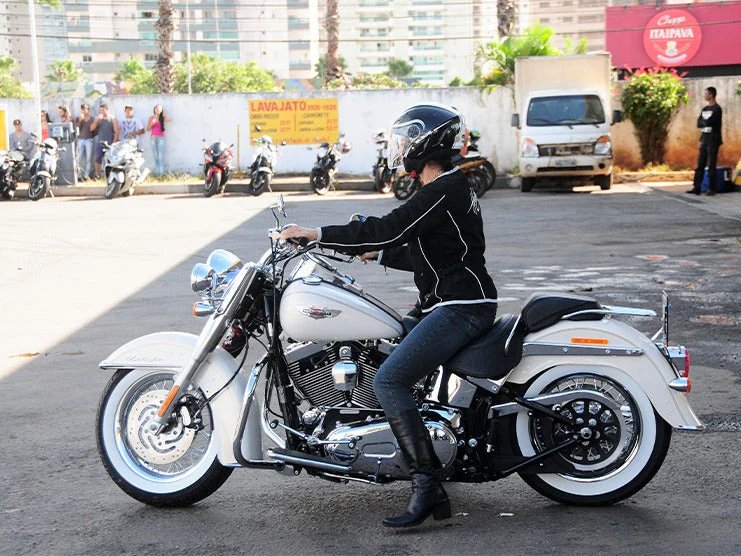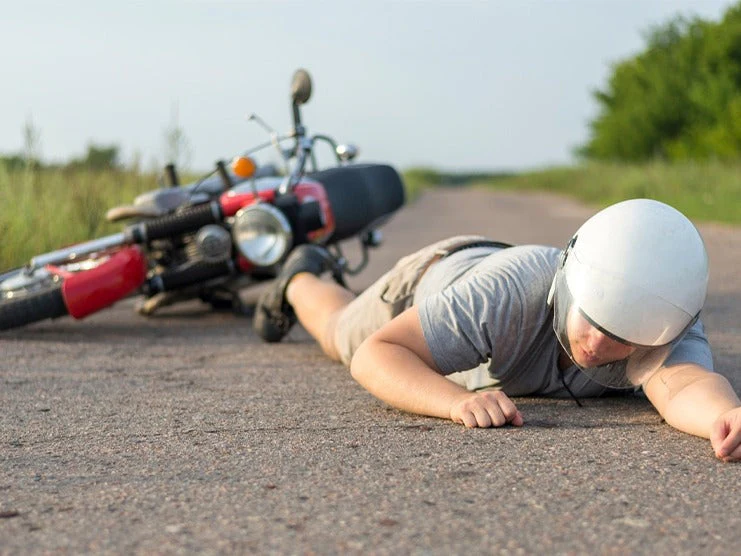Riding a motorcycle can be entertaining, cool, and economical. However, it is riskier to operate a motorcycle than any other vehicle. When riding a motorcycle, make sure to always follow the rules of the road to ensure safer travel.
Many motorcycles often travel on city roads which can come with certain risks. To ensure safer riding, you’ll need to take extra precautions when traveling on a busy city road.
Check out the following tips on how to stay safe when riding a motorcycle through the city.
Table of Content

1. Wear Appropriate Riding Gear
When riding a motorcycle, always wear a helmet whether it is mandatory in your state or not. Without a helmet, the risk of head injuries increases even at low speeds. Helmets can't prevent all head injuries, but they can help reduce their severity.
Do not wear shorts, t-shirts, or sandals when riding a motorcycle. If you skid across the road, long pants offer some measure of protection from injuries. If you want the best protection possible, choose leather or bulky coats, trousers, and boots. If you have an open-face helmet, wear goggles or glasses to protect your eyes and gloves to protect your hands.
2. Be Visible
Because motorcycles can be harder to spot, it's vital to improve visibility so that other drivers can be aware of your presence.
Unfortunately, not all drivers are alert or can see you clearly. Be prepared to react if a vehicle starts to shift into your lane or turn towards you. Watch the movements of nearby cars and the front tires for any signs they are about to merge.
Even if you are certain the nearby drivers have spotted you, always try to stay out of any blind spots.
3. Know Your Escape Lanes
Due to not having a bulky chassis like four-wheelers, even a small collision could prove fatal for motorcyclists. It is crucial to know where an escape route or lane is.
You have to be able to get out of the way in case the traffic in front of you suddenly c blocks your route. You have enough time to react to danger if you plan ahead. Otherwise, you run the risk of colliding with a car stopped ahead or moving into your lane.
Maintain a safe distance between you and the vehicles ahead so you have room to maneuver. Make sure to signal to the vehicles behind using turn signals and brake lights.
4. Check Road Conditions
Make sure to check the road conditions and nearby surroundings. Road hazards like potholes, loose gravel, and uneven terrain can cause you to lose control of your motorbike. It's also important to keep your distance from other vehicles since they might hurl debris at you. Travel at slower speeds to reduce the likelihood of slipping or losing traction.
5. Be Cautious at Intersections
Cities have several roads with intersections. Make sure the car ahead of you has cleared the space when waiting to turn at an intersection. Do not assume the driver ahead can see you or you risk accidentally colliding with the rear fender. When at an intersection, look out for incoming traffic in your rearview mirror and leave enough space between your bike and the vehicle ahead.
6. Adjust Mirrors
Mirrors help improve awareness of your surroundings and let you spot any incoming vehicles. However, many motorcycles lack proper rearview mirrors. When modifying your motorcycle, make sure to install bike mirrors that show the sides and rear. However, you can't angle the mirrors back too far or you reduce side vision and overlap the mirrors’ fields of view. Be discerning when choosing the position of the mirrors to maximize your vision.
Keep in mind that mirrors do not completely eliminate blind spots. Always look over your shoulder before changing lanes. Ideally, you should be able to see most of the road in front, behind, and along either side.
7. No Drugs
Do not ride your motorcycle immediately after taking prescription medications. They can have adverse effects that can reduce reaction time and cause dizziness or drowsiness. Before you ride, be mindful of the adverse effects of medications you're taking for high blood pressure, diabetes, depression, and other conditions. Speak with your doctor about any health concerns, medicines, and other effects that could affect your ability to operate a motorcycle safely.
8. Avoid Riding at High Speeds
Your braking distance tends to increase the faster your motorcycle travels. For example, if you are traveling at 60 mph, your braking distance increases to around 200 feet. Consider reducing your speed if there are road conditions like wet pavement, poor visibility, or heavy debris.
9. Following Distance
Traveling too closely to the vehicle ahead of you can increase the likelihood of getting into an accident. However, putting more space between you and any other cars significantly lowers the risk of a collision. More space between vehicles gives you more time to react and apply the brakes.
To gauge a minimum safe distance, start counting when the vehicle ahead passes a specific landmark. If you count two seconds, you're too close. If your bike doesn't have ABS or you're traveling at high speed, you might want to increase the buffer space.
10. Situational Awareness
Use the rearview mirrors and swivel your head to scan your surroundings. Try not to tailgate or allow other drivers to tailgate you; instead, leave some distance between you and the surrounding traffic. A bigger buffer space gives you time to anticipate incoming hazards and take appropriate action.
11. Braking
Always leave enough space between you and the car ahead. Apply the brakes gently to keep them from locking up and causing your vehicle to suddenly halt. To improve your vehicle’s braking, consider installing an ABS if there is room. According to the IIHS, ABS brakes can reduce the risk of a fatal collision by 22%.
12. Check the Weather
The weather can have a huge impact on road safety. Road conditions can become dangerous due to bad weather, with icy or wet roads reducing traction for two-wheelers. In severe circumstances, snow and rain can reduce visibility and make it difficult to see other vehicles. Wear reflective clothing to help capture what little natural light is available and make yourself more visible to other drivers. Wearing reflective riding gear is advised for riding in stormy weather and in the evening.
13. Follow Traffic Lights
Be cautious when approaching a filter lane directed by separate traffic signals. If the filter lane lights haven't changed when you use one of the lanes to pull out in front and speed into the straight-ahead lane during a green light, you've broken the law.
Gauge the distance when approaching a yellow light. If you are too far, apply the brakes and stop before the traffic line. Do not speed toward a yellow light or you may risk running a red light.
14. Be Careful When Making Left Turns
Be cautious when making a left turn since incoming traffic from the other lane may not see always you, especially if there are vehicles ahead of you.
To alert traffic that you are making a left turn, flash the turn signals or lightly hit the horn.
15. Focus On the Road
Keep your focus on your surroundings, speed, road conditions, traffic, weather, and road hazards.
To improve focus before and during a ride, inhale while counting four seconds, hold your breath, and then exhale. This breathing exercise has a calming effect that can help improve your focus. Diaphragmatic breathing is another exercise that can help improve your concentration while riding.
16. Road Positioning
When riding a motorcycle, try to stay in the center of the lane to avoid getting too close to other vehicles in adjacent lanes. When changing lanes or preparing to turn, make sure to maneuver in a way that makes you visible to other vehicles' mirrors. If you spot any road hazards, try to stay as far away from them as you can without getting too close to other vehicles.
17. Inspect Your Motorcycle
Before hitting the road, make sure to closely inspect your motorcycle. You should always check the mirrors, lights, and tire pressure. Also, make sure to inspect and repair any leaks, loose bolts, or other mechanical issues.
Make sure to follow a regular maintenance schedule, fixing the suspension, adjusting the chain, changing the oil, and replacing worn-out tires and brake pads.
18. Avoid Getting Between A Vehicle and An Off-Ramp
Drivers who do not want to miss their exit may suddenly change direction at the last minute. A driver suddenly trying to get to an off-ramp could result in colliding with the rear fender. As a rule of thumb, never position yourself between a vehicle and an offramp.
19. Ride in Open Zones
Take advantage of your motorcycle’s maneuverability and power output when riding in open zones. If there are gaps between lines of traffic, you can attempt to ride in these openings. This will keep you out of blind spots and give you more room to maneuver.
20. Stay in Your Comfort Zone
Know your limitations when choosing a motorcycle and traveling on certain types of roads. Your motorcycle should allow you to rest your feet on the ground, not be too heavy, Easy to reach the controls and handlebars, and can get on and off your motorcycle without issue.
Try to travel routes you are familiar with. The more familiar you are, the easier it will be for you to focus on safety instead of worrying about directions. For safety and comfort, you should install crash bar, sissy bar, handlebar, and backrests and for storage, you can install saddlebags.
21. Takeaway
For motorcycle riders, it can be easy to get distracted while riding through city roads due to being bombarded constantly by outside stimulus. It’s crucial to know the right tips to ensure better safety when riding a motorcycle. When navigating through traffic in the city, wear proper riding gear, check the road and weather conditions, maintain appropriate following distance, follow traffic lights, avoid drugs, maintain your focus, and stay in your comfort zone.













Leave a comment
All comments are moderated before being published.
This site is protected by hCaptcha and the hCaptcha Privacy Policy and Terms of Service apply.